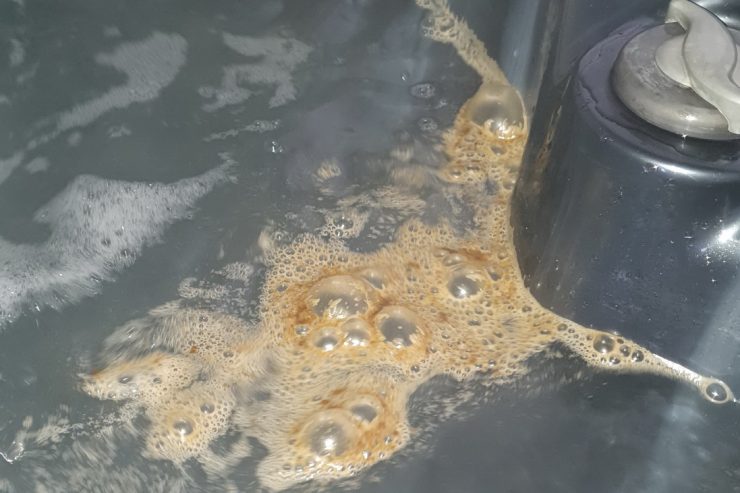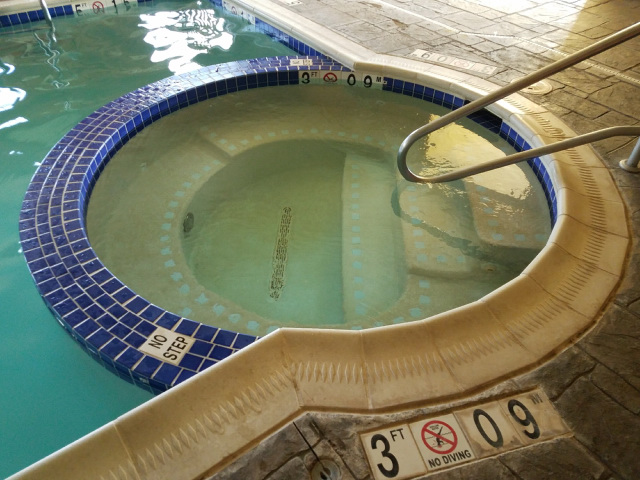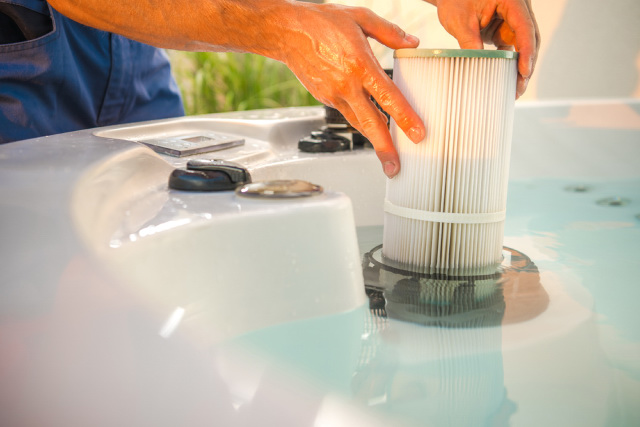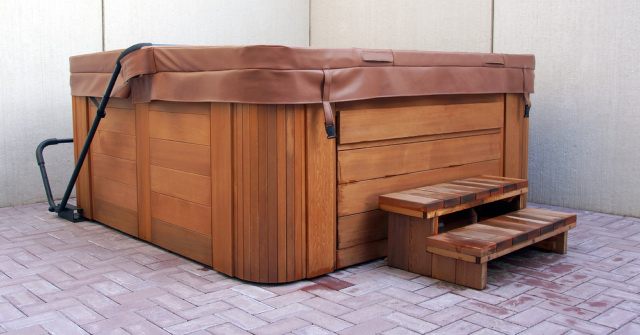Few things can ruin your hot tubbing plans faster than murky water. However, you had looked forward to using your hot tub all day and still really wanted to. Can you swim in a hot tub with cloudy water?

Cloudy hot tub water is not safe to swim in, as you could develop hot tub rash, skin and eye irritation, swimmer’s ear, or bacterial pneumonia. Cloudy water is caused by chemical imbalances, dirty filters, old (and unclean) water, or a lack of sanitizer, which can all lead to dangerous health issues.
This guide to murky hot tub water will explore why cloudiness is dangerous for your health and how to improve the clarity of the water for safer swimming.
Most Dangerous Health Risks of Cloudy Hot Tub Water
Cloudy, hot tub water has a lot of health risks associated with it, as cloudy water is a sign that the hot tub maintenance is poor. Combine this with the warm moist conditions of a hot tub, and you have the perfect breeding ground for bacteria.
Let’s take a closer look at the health risks you and your family or friends could face from an unclean hot tub.
1. Hot Tub Rash
At the very least, swimming in a murky hot tub can give you a hot tub rash or AKA pseudomonas folliculitis. Hot tub rash is due to pseudomonas bacteria in the water and is caused by a poorly maintained hot tub.
Cloudy, hot tub water is an indication of a poorly maintained spa.
Usually, symptoms start a few days after you sit in the hot tub. You will feel itchy after a dip; scratching the skin can further agitate it. You might have bumps or puss-filled blisters around the hair follicles.
A hot tub isn’t the only source of Pseudomonas. Water parks, ponds, lakes, rivers, and streams can also cause it.
2. Eye & Skin Irritation
Swimming under the water in a cloudy hot tub can give you eye irritation for your troubles. Your eyes might feel like they’re itchy or burning and look red. Cloudy water can also cause irritated skin.
An incorrect pH level or chloramines usually cause both of these.
pH
pH is a two-part issue for swimmers in tubs. Firstly, for the comfort of bathers, the pH of a hot tub should be 7.2-7.6. Anything outside of this will cause eye and/or skin irritations.
Incorrect pH in a tub also leads to cloudy water and can reduce the sanitizer’s effectiveness, whether chlorine or bromine.
Chloramines
Chloramines result from chlorine going to work to kill germs and bond with pee, poop, sweat, and other human waste. This is a good thing. But if too many chloramines are in the water, it’s not good news for swimmers.
Excess chloramines can cause burning or stinging eyes, cause red eyes, and irritate. Chloramines are also responsible for the “chlorine” smell. If you have this, it generally means you don’t have enough sanitizer in the water. Your best bet to eliminate these excess chloramines is to super chlorinate or shock the hot tub.
3. Swimmer’s Ear

Pseudomonas can also contribute to a swimmer’s ear, which causes symptoms such as a full feeling in the ear, muffled hearing, ear canal swelling, pus drainage from the ear, redness, pain, and itching.
For ongoing symptoms, see your doctor. Doctors often prescribe antibiotics to treat swimmers’ ears.
To help prevent swimmer’s ear in your hot tub, dry your ears after swimming and ensure the sanitation levels are 1-3 ppm for chlorine or 2-5 ppm for bromine. pH should also be 7.2-7.6.
4. Legionnaires’ Disease
Outbreaks of Legionnaires’ disease are associated with hot tubs. In 2019, an outbreak of the disease hospitalized 98 people, and 4 died after walking by a hot tub display at the North Carolina Mountain State Fair.
Legionnaires’ is a type of bacterial pneumonia, which can bring on symptoms such as fatigue, chest pain, breathing issues (feeling unable to breathe or breathing quickly), coughing with mucus, and a fever of more than 100.4 degrees Fahrenheit.
Hot tubs create favorable conditions for Legionella growth. One key condition is the temperature. Legionella grows best between 77–113°F (25–45°C).
As I’ve mentioned, cloudy, hot tub water means your hot tub isn’t being maintained properly. To reduce any chances of this deadly disease, ensure that the water is replaced regularly, you have the appropriate amount of sanitizer, and that the other chemicals are balanced. Biofilm and sediment should be removed, and water should be changed regularly.
5. Diarrhoea, Vomiting, Abdominal Pains
Cryptosporidium is a microscopic parasite that is spread through feces. The cryptosporidium bacteria can lead to diarrhea, nausea, vomiting, and dehydration.
Crypto can be spread more easily if your hot tub is cloudy and the maintenance isn’t top-notch.
If an infected person enters the water, it doesn’t take much to spread the infection. Symptoms appear 5-7 days after infection, lasting up to two weeks in most cases. For immune-compromised people, the infection can be fatal.
The biggest difficulty with crypto is that normal levels of sanitizer do not kill it. What does get rid of it, though, is filtering the water multiple times, good bathing habits i.e. showering before entering the hot tub, and super chlorination.
What Causes Cloudy Hot Tub Water?

You can’t correct what you don’t understand, so let’s go over the causes of a cloudy hot tub. We have a full article on fixing cloudy hot tub water, so we’ll just go over the basics here.
- Old Water
Old water contains all sorts of skin oils (and sloughed skin), chemicals, and gunk that can make the water cloudy. - Sunscreen and Body Products
Body products such as cologne, perfume, deodorant, body glitter, anti-aging products, makeup, and acne products come off when swimming in a hot tub and will affect the water. - Dirty Filters
Hot tubs rely on a filter to catch contaminants. - Lack of Sanitizer
Sanitizers should be added at least weekly. If you don’t, your spa will fall into disarray. - High pH
When the pH of the hot tub water begins to skyrocket, scale and calcium accumulations will make the water murky and dull. - Water Quality
Do you use filtered water for your hot tub? Tap water that’s high in metals could make your spa murky. - Air Contaminants
Contaminants in the air can settle on the surface of the water, everything from seeds to pollen and algal spores.
Preventing Health Problems from Cloudy Hot Tub Water
Ensuring your hot tub doesn’t cause any health issues begins with these methods.
1. Change the Water Regularly
Remember, you shouldn’t wait longer than three to four months to replace the water in your hot tub. This will remove any lingering bacteria, dead skin, and residue from sunblock and skin products.
2. Sanitize Often
Make sanitizing a weekly part of your hot tub maintenance routine moving forward. And ensure you test the levels regularly.
SpaChoice sanitizing granules are available in two or five-pound containers, and you can shop in packs of 12, so you’re stocked up for a while. You can get it here:
- Dissolves quickly and completely
- Stabilized spa chlorine
- Controls algae
The granules contain 56 percent stabilized spa chlorine to prevent algae and other bacteria. They dissolve in the heat of the water, so you don’t have to worry about a gritty feel when using your hot tub.
3. Circulate the Water
Stagnant water leads to bacterial growth. So it’s important to use your hot tub jets to move the water in the spa regularly, even if you’re not using it. This is especially true after applying chemical treatments and after use. The water circulation will help the chemicals move throughout the hot tub for a more thorough cleaning.
Using the jets after swimming in the hot tub will send the dead skin and other contaminants through the spa so the filter can catch them.
4. Change the Hot Tub Filter

Your hot tub filter is useless if dirty, as it can no longer catch contaminants. Your filter might last a year or longer, but you’ll need to clean it regularly (every 2-4 weeks). And checking it more frequently never hurts.
5. Test Chemical Levels
Is your hot tub water balanced? You can quickly answer that question by testing the water. You should do this a few times per week or even after every use if you’re in your spa daily.
Watch the sanitizer levels, as when these deplete; your hot tub is likelier to become cloudy. Ensure the water doesn’t become too alkaline, as it can develop calcium that will make it chalky.
Adjust bromine and chlorine levels until you get the chemical balance under control.
A good pH level for hot tubs is 7.4 to 7.6. Sodium carbonate can increase the pH if yours drops too low, whereas sodium bisulfate can decrease the pH.
Finish up by using a clarifier or flocculant. The former gets rid of big particles, and the latter smaller particles. After applying these products, give the filter 12 hours to run to spread the clarifier and flocculant throughout the water.
6. Shock the Hot Tub
Shocking is recommended even when your hot tub chemical balance is correct, but the water still looks cloudy. Use non-chlorine shock for chloramines, as that will change them to active chlorine.
Apply the appropriate amount of shock recommended, and stay out of your hot tub for at least the next 24 hours.
7. Put a Cover on When Not in Use

You can’t prevent airborne contaminants while enjoying your hot tub, but you can stop them from entering the spa any time. Place a cover on your hot tub when you’re done swimming. Ensure the cover is designed for your spa make and model and fits securely.


